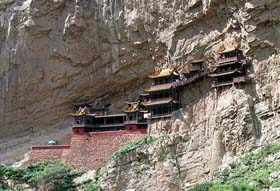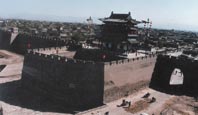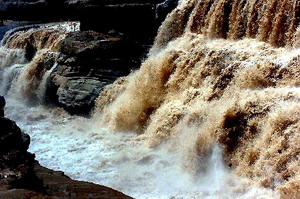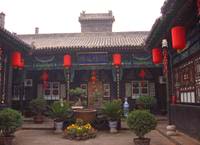Hanging Temple

Hanging Temple stands at the foot of Mt. Hengshan, 5 kilometers (3 miles) south of Hunyuan County, and 65 kilometers (40 miles) from downtown Datong City. Since it hangs on the west cliff of Jinxia Gorge more than 50 meters above the ground, it is called Hanging Temple.
Hanging Temple, built in 491, has survived more than 1400 years. The extant monastery was largely rebuilt and maintained in the Ming Dynasty (1368-1644) and Qing Dynasty (1644-1911).
How could a building like this withstand the winds and storms of so many years? Hanging Temple is an architectural wonder. A unique mechanical theory was applied to building the framework. Crossbeams were half-inserted into the rock as the foundation, while the rock in back became its support. Seen from below, Hanging Temple appears to be a tumble-down castle in the air. Inside, Hanging Temple provides the same scene as other temples.
Construction experts from countries including Britain, Germany, and Italy, come to see the monastery. In their words, Hanging Temple, which mixes mechanics, aesthetics, and Buddhism, is rare. The monastery and everything it symbolizes embodies a great cultural achievement of Chinese people.
The second attraction of Hanging Temple is that it includes Buddhism, Taoism and Confucianism. Inside the monastery, the sculptures of Sakyamuni, Confucius and Laotzu appear together, which is unusual. There are 40 halls and cabinets, which contain about 80 sculptures made of copper, iron, terracotta, and stone. The features are vividly carved.
Why build a monastery like this? Location is the first reason; building a monastery on the cliff could shield it from floods. In addition, the mountain peak protects it from rain and snow; and the mountain around it also diminishes damage from long-time sunshine. The second reason is that the builders followed a principle in Taoism: no noises, including those from rooster crowing and dog baying; so from the upper ground, all noises drop away.





